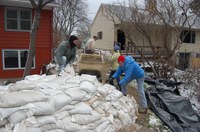Be Prepared for Flooding
(Click the image below to view a high-resolution image that can be downloaded)
Planning is a vital part of fighting a flood.
“Knowing what to do will help keep you and your family from panicking and having to make last-minute decisions,” says Ken Hellevang, North Dakota State University Extension agricultural engineer and flooding expert.
NDSU Extension has several resources to help you prepare for a flood. Visit NDSU Extension’s flood website at https://www.ag.ndsu.edu/flood for more information.
Here are some tips to help you be prepared in case flooding occurs in your area:
- Check with your local officials for information on the risk of flooding in your area, then listen to the radio, watch TV or visit your city or county’s website for the latest flood information.
- Make sure your sump pump is operating properly.
- Move snow away from the house to limit potential for seepage into the basement. Also move snow away from the foundations of other buildings.
- Get downspouts in place so they carry melting snow away from your house.
- Build a dike around your home or other structure if flooding is expected or obtain supplies to build a dike.
- Keep water out of window wells. Build dams and contour the ground so water drains away from the house.
- Gather water, food that doesn’t need cooking or refrigeration, a nonelectric can opener, battery-powered radio and flashlights and extra batteries in case you lose electrical power. A fuel-powered lamp, camp stove and fire extinguisher also are helpful.
- Verify that your tetanus vaccination is up to date.
What to Do in Your Home
- Put furniture and large appliances such as freezers, washing machines and dryers on wood or cement blocks to keep their motors above floodwaters or move them to an elevated location.
- Turn off electrical power to flood-threatened appliances at the electrical panel. Also shut off power to parts of your home or other buildings that could be flooded.
- Have a backup power source, such as a standby generator.
- Plug basement floor and other drains (toilets, showers, washing machine, sinks) with removable plugs if sewer backup is possible.
- Move valuables (irreplaceable family photos, tax records, insurance policies and household inventories) and hazardous material (paint, oil and cleaning supplies) to higher locations.
Protecting Rural Areas
- If you have a septic system and the drain field is flooded or saturated, plug all basement drains and drastically reduce water use in the house. Don’t run water from a basement sump pump into the septic system, let water from roof gutters or the sump pump discharge into the drain field, use the dishwasher or garbage disposal, or do laundry.
- Move livestock, machinery, feed, grain, fuel and agricultural chemicals, and motors and portable electric equipment to higher ground. Have an inventory of your livestock and other property, and a list of any hazardous or potentially hazardous substances.
- Anchor lumber, logs, irrigation pipes, fuel tanks and other loose equipment or material to keep it from floating away in floodwaters.
- Place riprap on the banks of earthen manure storage areas that may be subject to erosion.
- If you have a well that will be flooded, turn off the power to it and install a watertight cap or cover. If you don’t have time to install a cap, cover the top of the well with heavy plastic sheeting and secure it with waterproof tape (not duct tape) to keep floodwater out.
Evacuation
- Assemble supplies for a possible evacuation. They include some water; nonperishable food; disposable plates, cups and utensils; clothing; blankets or sleeping bags; a first aid kit; prescription medication; special items for babies or the elderly; cash and credit cards; and important phone numbers.
- Make an evacuation plan. Decide where you would go if you are forced to evacuate, such as a family member or friend’s home or a local shelter. Know how to get there, especially if some streets or roads are flooded. Then practice your plan.
- Designate a contact person for family members to call in case they get separated while evacuating. Make sure everyone has the contact person’s phone numbers.
- Make a plan for pets. Shelters usually don’t allow pets because of health issues.
- Keep your vehicle fueled in case you have to evacuate because gas stations may have been flooded or can’t operate because of a power outage.
NDSU Agriculture Communication - March 21, 2019
| Source: | Ken Hellevang, 701-231-7243, kenneth.hellevang@ndsu.edu |
|---|---|
| Editor: | Ellen Crawford, 701-231-5391, ellen.crawford@ndsu.edu |


